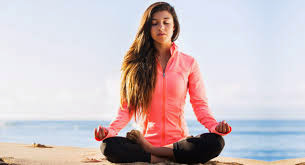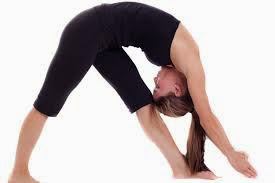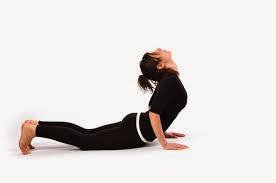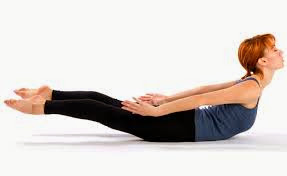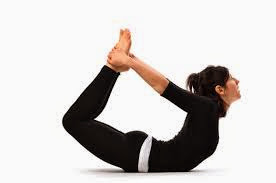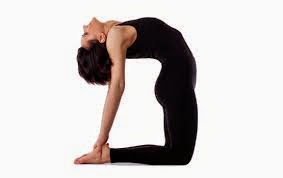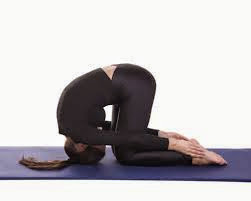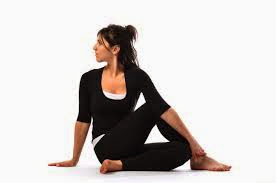What is healthy yoga??
The word yoga, from the Sanskrit word yuj means to yoke or bind and is often interpreted as “union” or a method of discipline. A male who practices yoga is called a yogi, a female practitioner, a yogi. The Indian sage Patanjali is believed to have collated the practice of yoga into the yoga Sutra an estimated 2,000 years ago. The Sutra is a collection of 195 statements that serves as a philosophical guidebook for most of the yoga that is practiced today. It also outlines eight limbs of yoga: the vamas (restraints), niyamas (observances), asana (postures), pranayama (breathing), pratyahara (withdrawal of senses), dharana (concentration), dhyani (meditatio), and samadhi (absorption). As we explore these eight limbs, we begin by refining our behavior in the outer world, and then we focus inwardly until we reach samadhi (liberation, enlightenment).
Today most people practicing yoga are engaged in the third limb, asana,
which is a program of physical postures designed to purify the body and provide
the physical strength and stamina required for long periods of meditation.
- Mental relaxation
- Heals lower back pain
- Strengthens lower extremities
- Improves central nervous system Reduces diabetes
- Flexibility
- Better blood flow
- Helps constipation
- Cardiovascular benefits
- Helps to balance body & mind
- Balances blood sugar level
- Gives a boost to the immune system
- Improves the function of kidneys
- Decreases body toxins
Yoga
1. Pranayama:1. Beginners can start with deep breathing practice in sitting position (Padmasana - Lotus, Swastikasana- Auspicious, Vajrasana - Thunderbolt, Any Cross legged position in which the body can be relaxed and spine is erect.)
2. Then start creating hissing sound
with breathe, this sound is NOT produced in vocal chords but produced by
contraction of throat or epiglottis. Or you may contract the throat and make
frictional sound.
3. Initially 4 seconds inhale
through both nostrils while creating Ujjayi sound and exhale for 6 seconds
through both nostrils creating sound, this can be practiced for about 5
minutes.
With practice one can increase
the counts to 4:8, or 5:10 or 6:12 seconds
4. This Ujjayi sound can also be
created while doing Asanas. This helps release the stresses faster and makes
the mind focused easily.
2. Ardha-Chandrasana (Half Moon Pose)
Step 1- Stand straight.
Step 2- Put your hands upwards and straight.
Step 3- Join the palms.
Step 4- Bend
your body towards left. Your body should be able to make a “C”.
3.Utkatasana (Awkward Pose or Chair Pose)
Step 1- Stand straight.Step 2- Then, breathe in and raise your hands up. Your hands should be pointing in the same direction,
where your face is pointing. Your palms should be parallel to each other.
Step 3- Now, bend your knees.
Step 4- Exhale and stand on your toes. Try to balance your body weight. Your posture should be as if you are sitting on a chair.
4. Garurasana (Eagle Pose)
Step 1- Stand straight.
Step 2- Now, bend your knees.
Step 3- Wrap your left thigh on the right one and balance
your body on the right foot.
Step 4- Raise your hands straight in such a way that they
are parallel to the floor.
Step 5- Now, cross your arms. Remember, your right arm
should be above the left one.
Step 6- Bend your elbows. Your forearms should be
perpendicular to the floor, and the back of your hands should be towards each
other.
Stay in this pose for 15-20 minutes. Repeat the same
with the legs and arms reversed
5. Dandayamana Janushirasana (Standing Head to Knee)
Step 1- Stand straight. In this yoga pose, balancing your
body is very important; otherwise, you will fall. So, first try to balance your
body.
Step 2- Bring your right leg upwards. Your legs should form
a 90-degree angle with the floor.
Step 3- Hold your lifted toe with both of your hands.
Remain in this position for a minute.
Step 4- Take a deep breath. Then, exhale and begin to lower
your upper body, slowly. Try to bring your forehead closer to your leg, as much
as you can.
Stay in this pose for a while and then, return to normal pose. Repeat it
with the other leg.
6. Dandayamana Dhanurasana (Standing Bow Pose)
Step 1- Breathe in and stand straight.
Step 2- Raise your hands upwards and inhale & exhale
normally.
Step 3- Slide your right leg backwards and bend it.
Step 4- Try to raise your right leg upwards and hold your
right toe with your right hand.
Step 5- Put your left hand forward and raise it. Your elbow
shouldn’t be bent. Your palm should face the ground. Your left hand’s fingers
and your face should point at the same direction.
Step 6- Hold this position for 15
seconds, balancing your body.
Step 7- Return to your original posture and repeat with the
other leg.

7. Tuladandasana (Balancing Stick Pose)
Step 1- Stand erect and inhale.
Step 2- Raise both of your hands upwards and join your
palms. This will help you in balancing your body.
Step 3- From tailbone to your head, bend your body forward.
Step 4- Point your joined hands in the same direction where
your head is pointing.
Step 5- Raise your right leg backwards and your right knee
shouldn’t be bent.
Step 6- Your body should form a
perfect “T”.
Step 7- Hold this posture for 15 seconds.
Step 8- Return to original posture and repeat this pose
with the other leg
8. Dandayamana Bibhaktapada Paschimotthanasana
(Standing Separate Leg Stretching Pose)
Step 1- Keep your breathing normal and stand erect.
Step 2- Slide your legs apart, but both your legs should be
in one line. Your legs should form “/\” sign. Your knees should be straight.
Step 3- Bend
your body forward, from waist to head. Keep your bended body close to your
legs.
Step 4- Your head should touch the floor. Now, hold both of
your feet with your palms. Don’t stretch your body too much if you are doing
this yoga for the first time.
Step 5- Keep your butt out. To maintain the balance of your
body, put your weight on your toes.
Step 6- Stay in this position for 60 seconds or so. Then,
slowly return to original position by standing straight.

9. Trikanasana (Triangle Pose)
Step 1- Stand erect and breathe in.
Step 2- Point both of your hands towards the ceiling and join your palms.
Step 3- Slide your right leg outwards and don’t bend your knee, it should be straight. Both your feet should be in the same line.
Step 4- Bend your left knee.
Step 5- Bend your body towards your left knee.
Step 6- Put your left hand down and touch your left toe with your fingers. Keep your right hand upwards and straight.
Step 7- Look upwards, in the direction, where your right hand is pointing.
Step 8- Stay in this position for 5 minutes or so.
Step 9- Come to your original posture by standing straight.

10. Dandayamana Bibhaktapada Janushirasana (Standing
Separate Leg Head to Knee Pose)
Step 1- Stand while keeping your spinal cord straight.Step 2- Keep your hands upwards and pointed towards the sky. Join your palms.
Step 3- Put your right leg forward and lock both of your knees.
Step 4- From waist to head, bend
your body forward.
Step 5- Your body should be bent in such a way that your
head touches your right knee.Step 6- Put your hands down and touch the floor with your fingers. Your hands should be joined, and your elbows should be locked.
Step 7- Stay in this position for like 5 minutes or so.
Step 8- Slowly come in a straight posture.
11.Tadasana (Tree Pose)
Step 1- Inhale and stand straight.
Step 2- Keep your mind calm.
Step 3- Balance your body on left leg, else, you will fall.
Step 4- Bring your hands close to your chest and join your palms like you do while praying.
Step 5- Bend your right knee in front of left upper thigh. Remember, the sole of right knee should be towards ceiling.
Step 7- Concentrate on a point to relax your mind.
Step 8- Stay in this position for 10 to 12 seconds.
Step 9- Put your right leg down and come to a straight standing position.
12. Padangustasana (Toe Stand Pose)
Step 1- Stand straight and take a deep breath.
Step 2- Sit down bending your knees and keep your back
straight.
Step 3- Try to sit on your toes by balancing your body
weight.
Step 4- Slowly raise your right leg and put your right toe
on your left thigh.
Step 5- Raise your hands and join your palms. Your hands
should be in a prayer position.
Step 6- Stay in this position for
as long as you can.
Step 7- Slowly remove your right leg from your thigh and
come in the original position.
13. Savasana (Dead Body Pose)
Step 1- Keep your mind quiet and calm.
Step 2- Lie down supine on the floor.
Step 3- Put your hands on the ground in a relaxed position.
Step 4- Keep your body relaxed.
Step 5- Your eyes should be open. Concentrate at a point on the ceiling.
Step 6- Take a deep breath and slowly inhale and exhale.
14. Pavanamuktasana (Wind-Removing Pose)
Step 1- Lie down on the floor. Your body should face the ceiling.
Step 2- Exhale and bend your both knees towards your chest.
Step 3- Tightly hold your right knee with both of your
hands.
Step 5- Straighten your left leg and lock your left knee.
Step 6- Hold this posture for some time.
Step 7- Finally, bring back both the knees towards your
chest.
Step 8- Exhale and comfortably pull out both knees along
the floor.
15. Pada-Hasthasana (Sit-Up Pose)
Step 1- Bring your body in Savanna pose.
Step 2- Raise your hands overhead and join your palms.
Step 3- Sit up while inhaling.
Step 4- Keep your legs straight.
Step 5- Bend your body forward (head to waist).
Step 4- Put your forehead on your knees.
Step 5- Bend your elbows and touch your toes with your palms.
Step 7- Stay in this position for 2 minute
16. Bhujangasana (Cobra Pose)
Step 1- Lie prone on the floor.
Step 2- Put your palms on the floor.
Step 3- Slowly lift your body, from waist to head, upwards.
Step 4- Keep your head upwards.
Step 5- Keep your toes outwards and knees should be locked.
Step 6- Stay in this position for as long as you can.
Step 7- Come in a comfortable posture.
17. Salabhasana (Locust Pose)
Step 1- Lie prone on the floor.
Step 2- Put your palms on the ground.
Step 3- First lift your right leg upwards while balancing
your body weight.
Step 4- Now, lift your left leg upwards and lock both the
knees. Shift your body weight on your palms.
Step 5- Stay in this posture for 5 minutes. Then, come in a
comfortable position.
18. Poorna-Salabhasana (Full Locust Pose)
Step 1- Lie prone on the ground.
Step 2- From your knees to toes, lift your legs and lock
your knees.
Step 3- Your toes should be outwards.
Step 4- Slowly lift your hands too and lock your elbows.
Step 5- Keep your head up and straight. Only your stomach
should touch the ground.
Step 6- Your body posture should be like a flying
aeroplane.
Step 7- Stay in this position for 10 to 12 seconds.
Step 8- Slowly; put your legs and hands down and come in a
comfortable posture.
19. Dhanurasana (Bow Pose)
Step 1- Bring your body in Poorna-Salabhasana pose.
Step 2- Bend your knees backwards.
Step 3- From knees to toes, raise your legs upwards.
Step 4- Put your hands backwards.
Step 5- Tightly hold your toes with your palms. Your body posture should be like a bow.
Step 6- Look upwards.
Step 7- Stay in this posture for 20 to 25 seconds.
Step 8- Slowly; leave your toes and rest comfortably on the ground.
20. Supta Vajrasana (Fixed Firm Pose)
Step 1- Stand erect.
Step 2- Sit while bending your knees backwards.
Step 3- Keep your spinal cord straight. Keep your breathing
normal.
Step 4- Bend
your body backwards and lie supine on the ground. Don’t straighten your knees.
Step 5- Elevate your hands overhead and fasten onto
opposite elbows.
Step 6- Your face should be upwards. Your chin should be
tucked into your chest.
Step 7- Your butt should be in contact with your toes.
Step 8- Stay in this position for 20 seconds.
Step 9- Start from relieving your hands and slowly, get
back to original posture.
21. Ardha-Kurmasana (Half Tortoise Pose)
Step 1- Stand straight.Step 2- Sit, while bending your knees outwards.
Step 3- Bend your body and lean forward.
Step 4- Put your head on the ground.
Step 5- Keep your hands straight and on the floor.
Step 6- Join the palms.
Step 7- Stay in this position for 20 seconds or so.
Step 8- Slowly straighten your legs and come to a normal posture.
22. Ustrasana (Camel Pose)
tep 1- Sit down while bending your knees backwards.
Step 2- Keep your body straight.
Step 3- Keep your hands backward.
Step 4- Keep your hands straight and lock your elbows, holding your toes.
Step 5- Bend your body backwards.
Step 6- Keep your head upwards.
Step 7- Stay in this position for 20 seconds.
Step 8- Slowly release your hands and sit comfortably.
23. Sasangasana (Rabbit Pose)
Step 1- Bend your knees outwards and sit down.
Step 2- Keep your spine cord straight.
Step 3- Bend your body forward and let your head touch the
ground.
Step 4- Keep in mind that your forehead should touch your
bent knees. Your chin should be in contact with your chest.
Step 5- Keep your hands backwards and straight. Lock your
elbows and hold your soles with your palms.
Step 6- Keep your toes towards the outside.
Step 7- Keep your body in this posture for 20 seconds.
Step 8- Lower down your back and comfortably release your
body from this posture.
24. Janushirasana with Paschimotthanasana (Head to Knee Pose with Stretching Poe)
Step 1- Inhale and sit down. Keep your legs forward and
straight. Keep your breathing normal.Step 2- From tailbone to head, keep your body straight.
Step 3- Bend and slide your right knee in such a way that your right toe will touch your left thigh (inside your
left leg).
Step 4- Bend your head forward and put it on your left knee.
Step 5- Your left toe should be straight, and your left knee should be locked.
Step 6- Hold your left toe with both of your palms.
Step 7- Stay in this position for 10 to 12 seconds.
Step 8- Repeat the same with the other leg. After that, come in the sitting position.
Step 9- Now, pull out both legs and keep them straight.
Step 10- Curve your upper body forward. Bend your elbows and touch your toes with your palms.
Step 11- Touch your forehead with your toes.
Step 12- After holding this pose for 15-20 seconds, return to initial posture.
25. Ardha Matsyendrasana (Spine Twisting Pose)
Step 1- Sit down with your legs forward and straight.
Step 2- Bend
your right knee in such a way that it comes up and over the left leg.
Step 3- Keep your left foot on the ground and fold it in
such a manner that left toe touches the right buttock.
Step 4- Slowly twist your body and put your right palm on
the ground, keeping your elbows straight.
Step 5- Bend
the elbow of your left hand and put it on your right knee.
Step 6- Look towards the right.
Step 7- Stay in this posture for 20 seconds or so.
Step 8- Slowly move your body and head and come in a straight
pose.
26. Kapalbhati in Vajrasana (Blowing in Firm Pose)
Step 1- Bend your knees backwards and sit down.Step 2- Keep the rest of your body posture straight.
Step 3- Put your hands forward. Your palms should be on your thighs.
Step 4- Lock your elbows.
Step 5- Your butts should touch your toes.
Step 6- Keep your stomach relaxed.
Step 7- Stay in this posture for as long as you can stay.
Step 8- Loose your body and sit comfortably.
Practice - Note (Practice of should be done with a Yoga Expert Only)

